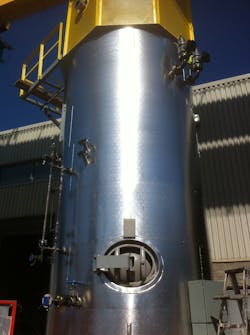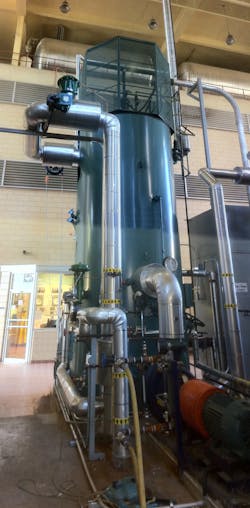District Heating Electric Boilers Suddenly in Vogue Again
By ROBERT PRESSER, Vice President, Acme Engineering Prod., Inc.
Due to the threat of global warming, as well as international commitments to the Paris Accord on Climate Change, municipalities and regions using district heating in Europe and North America are tasked with significantly reducing their environmental footprint in record time.
With district heating, towns or large areas typically receive heat and hot water, distributed to commercial, residential, or public buildings at greater economies of scale than individual heating systems.In response, last year the 27-nation European Union (EU) agreed to cut greenhouse gas (GHG) carbon emissions by 55% by 2030 compared to 1990 levels. According to a recent report that has tracked the EU's power sector since 2015, renewables surpassed fossil fuels last year (38% to 37%), indicating that municipalities relying on district heating are already pivoting away from often inefficient, outdated equipment that produces excess carbon emissions.
Even the U.S., which recently rejoined the Paris Agreement, now has targets for American businesses to achieve a carbon pollution-free power sector by 2035, and a net-zero economy by 2050.
While the interest of regions using district heating in electric boilers has waxed and waned in the last century, suddenly it is in vogue again.
Whether to honor Environmental Social and Governance (ESG) goals, to meet regulatory commitments, or to take advantage of government credits and incentives, a growing number of U.S. municipalities now are installing new or retrofit high-voltage electrode boilers that are compact, economical, and produce no emissions.
This is, in part, due to technological advances in electric boiler design that increase the output to a level that rivals even large gas or oil-fired boilers. When utilized for district heating, electric-powered alternatives are sure to be a critical piece of the puzzle to meet future emission reduction goals.
Dispelling Longheld Misconceptions
With district heating, besides the notorious GHG carbon dioxide (CO2) and methane (CH4), natural gas-fired boilers and furnaces emit dangerous nitrogen oxides (NOx), carbon monoxide (CO), and nitrous oxide (N2O), as well as volatile organic compounds (VOCs), sulfur dioxide (SO2), and particulate matter (PM).
However, many facility engineers familiar with gas-fired boilers mistakenly believe that electric boilers cannot match the output of the traditional, fossil fuel burning units. But due to considerable advances in electric boiler technology, that is far from the case. Today, such technology can match the capacity of large gas or oil-fired boilers in a much smaller footprint.
Electric boilers utilize the conductive and resistive properties of water to carry electric current and generate steam. An A.C. current flows from an electrode of one phase to ground using the water as a conductor. Since chemicals in the water provide conductivity, the current flow generates heat directly in the water itself. The more current (amps) that flows, the more heat (BTUs) is generated, and the more steam produced. Crucially, almost 100% of the electrical energy is converted into heat with no stack or heat transfer losses.
As an example, the electrodes of the CEJS High Voltage Electrode Steam Boiler by Acme, a Canada-based manufacturer of industrial and commercial boilers, are vertically mounted around the inside of the pressure vessel. This enables the unit to produce maximum amounts of steam in a minimum amount of floor space, with boiler capacity from 6MW to 52MW.
The boiler operates at existing distribution voltages, 4.16 to 25 KV, with up to 99.9% efficiency, and can produce up to 170,000 pounds of steam per hour. With pressure ratings from 105 psig to 500 psig, the boilers are designed to ASME Section 1, and are certified, registered pressure vessels at the location of the boiler.
There is an entire generation of district heating facility engineers that grew up with oil and gas-fired boilers almost exclusively. As a result of preconceived notions, most view electric boilers as small underpowered units, like a hot water heater. However, today there is electric boiler technology now available that can match the capacity of large gas or oil-fired boilers.
This technology is used for residential and commercial district heating, which is increasingly in demand, particularly within urban centers. With district heating, distributed heat is generated in a central location through an insulated pipe system, and utilized for high-efficiency, low-pollution, space and water heating. For central heating applications, electric boiler technology quietly supplies ample power for its compact size. This approach is currently being considered to install several 50MW steam boilers in the center of Manhattan (NYC), replacing gas-fired boilers to provide centralized steam to a number of buildings.
District Heating Upgrades and Electric Advantages
Typically, district heating upgrades are initiated due to high heating costs that customers find unaffordable, often due to expensive fossil fuels or an aging system that needs to be replaced. Increasingly, such upgrades are pursued to minimize environmental impact.
The upgrades often entail retrofitting or replacing boilers (the heat source) with cleaner, more efficient electric alternatives, along with the heat distribution network (pipes/ heat exchanger stations).
In addition, electric boilers have several advantages compared to oil or gas-fired boilers, including superior safety, ease of installation, faster start-up and shut down time, and quiet operation. Electric boilers do not have a high minimum operating level to make them immediately available.
Electric boilers also do not need an operator because if anything goes wrong, the breaker trips, preventing further escalation of the issue. With gas burning boilers, however, any gas leak can increase the risk of an explosion. So, gas units must usually be continually monitored or periodically inspected. State and municipal safety guidelines vary depending on boiler type and the expected frequency of inspection.
Energy input as well as adjustment is also precise and virtually immediate with electric boilers. In contrast, increasing or decreasing the temperature in a gas-fired boiler is a slower process because it takes time for the heat in the boiler to rise or dissipate before reaching the targeted output.
Finally, the electric units are also exceptionally quiet compared to fuel-fired boilers. Unlike gas-powered burners that throttle like turbine engines almost continually, electric boilers keep operational noise levels down. Because its loudest boiler component is a circulating pump motor, it is easy to have a conversation next to one without having to raise your voice.
As the EU and U.S. resolve to dramatically cut their GHG to combat climate change, the urgency for areas using district heating to similarly reduce their carbon emissions will only grow. In this battle to protect the environment before the global climate hits an irreversible tipping point, municipalities along with state and federal government, and the commercial sector must do their part.
Fortunately, advanced, zero-emission electric boiler technology can be a readily implementable part of the solution.
##########
Based in Montreal, the author is now in his 29th year at Acme Engineering, a maker of boilers for large industrial and commercial applications.The company is an ISO 9001:2015 certified manufacturer of environmental controls and systems with integrated mechanical, electrical and electronic capabilities. E-mail: [email protected].

